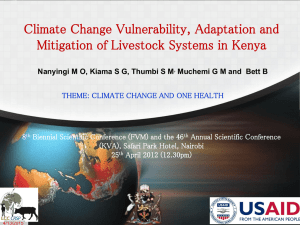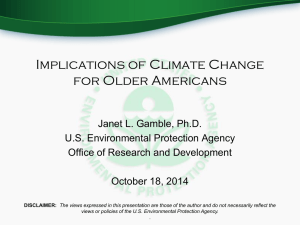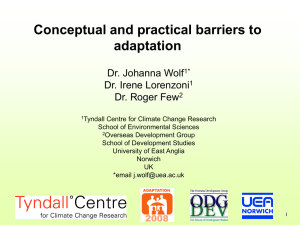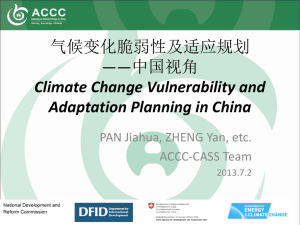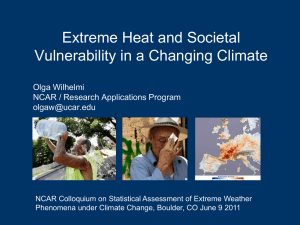Are Women more vulnerable to Climate Change?
advertisement
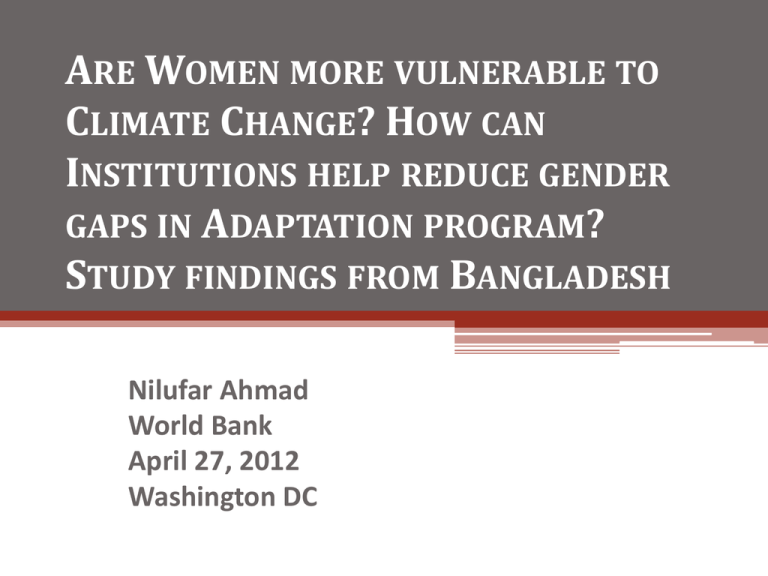
ARE WOMEN MORE VULNERABLE TO CLIMATE CHANGE? HOW CAN INSTITUTIONS HELP REDUCE GENDER GAPS IN ADAPTATION PROGRAM? STUDY FINDINGS FROM BANGLADESH Nilufar Ahmad World Bank April 27, 2012 Washington DC Why Understanding gender dimensions of climate change are important for adaptation? Climate Change has two major impacts 1. Increase in frequency and intensity of disasters 2. Incremental changes – sea level rise, salinity intrusion in soil and water, drought, glacier melt, variability in rain, • Impacts magnify the existing inequalities. • Gender-responsive disaster management achieved improved results: In 1991 cyclone, the number of death was over 140,000 and ratio of male: female death rate was 1:14. With gender-responsive disaster management, the male: female ratio has reduced to 1:5 and number of death to around 3000 (2007 Sidr) Objective and research questions Objective: to understand the gender dimensions of climate change, reasons for gendered vulnerability, and what actions can be taken that can reduce gender gaps and improve resilience of all. key research questions 1. are women more vulnerable than men to climate change? 2. If yes, what are the factors that make women more vulnerable? 3. what measures and adaptation support can be taken by government and other organizations to improve resilience of both women and men? Four key propositions for gender analysis • vulnerability to natural hazards is gendered due to social norms, entrenched gender inequality and domestic work • adaptive capacity is gendered as it is shaped by control over capitals, opportunities and agency • migration as an adaptive strategy is gendered, as women and men face different opportunities and challenges • access to institutions which can help build adaptive capacity is gendered Methodology • Quantitative and qualitative survey in 18 climate vulnerable sites in urban (3) and rural (6) areas, and 2 control sites. • Participatory Rural Appraisal (PRA) tools were used for qualitative survey • The quantitative survey included two questionnaires – a household module and a gender module • administered to 30 households at each site giving a total of 600 (420 rural, 180 urban) households. • The gender module was administered in separate interviews to both spouses. River Flood Prone Flash Flood Prone Drought Prone Drainage Congestion Prone Control Salinity Prone Cyclone Prone Landslide Prone Sea Level Rise Prone Tidal Surge Prone IPCC Framework for determining vulnerability to climate change • Exposure to climate variability and risks • Sensitivity to the risks • Adaptive capacity – ability to overcome and recover from external climate related stress, including ▫ Endowments of human, financial, natural, physical and social capital (sustainable livelihood framework) ▫ Entitlements -rights, voice WDR Gender Equality Framework • Accumulation of endowments/capitals • Use of endowments to take up economic opportunities and generate incomes • Applications of endowments and opportunities to take actions or agency (empowerment) Poverty status of surveyed households • Rural, 1. 49% poor, 49% functionally landless. 2. 56% HH depend on natural resource based livelihood. 3. Women lack economic opportunities (less than 10% women earn an income, compared to over 80% men). • Urban, 1. 27% poor. 2. 83% HH depend on non-natural resource based livelihood. 3. Over 40% women earn an income. Community Perception on level of Exposure to Hazard Risks and related Vulnerability (qualitative fieldwork) HOTSPOT HAZARD Exposure Risk Vulnerability NETROKONA Flood Medium High Drought Medium Low Drought High Moderate Flood Low Low Flood Very high Very high for women Land Erosion Very high Very high Tidal Surge Medium High for women Cyclone Low Low Cyclone High High Storm Surge Medium Moderate RANGAMATI Land slide High Low DHAKA Drainage Congestion Very high Low CHITTAGONG Sea Level Rise Low exposure Moderate KHULNA Salinity/water logging/ High Moderate COMILLA (CONTROL) Flood Low Low Drought Low Low RAJSHAHI GAIBANDHA COX’S BAZAAR BARGUNA Frequency and intensity of natural hazards is increasing in recent times 100 Yes No % of Respondent 80 60 40 20 0 Seasonal flood Flash flood Tidal flood Drought Cyclone Storm surge Water logging River/ coastal erosion Land slide Changing Climate Variability and Vulnerability of Households • Households are vulnerable to climate change induced multiple hazards annually • The dynamic and changing nature of climate variability is posing new threats to populations • Local hazards due to climate change are on the increase and have a major impact on affected population, but do not attract national attention • Households affected by local hazards are taking extreme coping actions that can lead to long term and intergenerational vulnerability • Social capital and collective actions weakening in climate vulnerable areas. Communities come together after major disasters, but local hazards e.g. scarcity of water, salinity is increasing conflicts. The Gender Dimensions of Climate Change Proposition 1: Vulnerability to Hazards is Gendered • Social norms shape women’s vulnerability to climate change • Social norms and family responsibility reduce women’s survival chances in rapid-onset climate events. • Inheritance law affects women’s adaptive capacity • Coping actions, conditioned by social factors, perpetuate vulnerability • Extreme coping actions are gendered and have different impacts, more women reduce food consumption, while more boys are withdrawn from school. • Women face specific difficulties during and after disasters – bathing and sanitation, collection of water and fuel Women face specific difficulties, more in urban areas sample -420 men and 420 women in rural . 180 men and 180 women in urban Urban Rural Male Faced difficulty in bathing and sanitation Reduced food consumption 100 90 80 70 60 50 40 30 20 10 0 Faced difficulty in firewood collection Female Children withdrawn from school Suffered from diseases Faced difficulty in water collection Faced difficulty in bathing and sanitation Reduced food consumption 100 90 80 70 60 50 40 30 20 10 0 Faced difficulty in firewood collection Children withdrawn from school Suffered from diseases Faced difficulty in water collection Increase in reported violence against women, especially in urban Areas, and among women from non-poor HH (sample 420 rural and 180 urban women) 35 35 Extreme Poor Moderate Poor 30 30 Moderate Non-poor 25 25 Non-poor 20 20 15 15 10 10 5 5 0 0 External physical External physical Domestic physical External verbal Domestic verbal Domestic physical External verbal Domestic verbal Proposition 2: adaptive capacity is gendered and is shaped by control over endowments, opportunities and agency • Households with higher levels of assets and endowments have more adaptive capacity • Adaptive and coping strategies are gendered, men have more options than women. • Rural women, from all income groups, have less control over all types of capital (human, social, natural, physical and financial) than men • Women’s limited ability to transform capital reduces their adaptive capacity • Lack of economic opportunities for women in rural areas • Restricted access to markets and institutions reduces women’s adaptive capacity • Egalitarian norms in indigenous communities strengthen the adaptive capacity of women (Rangamati) Women have less control over all types of capital, that reduces their adaptive capacity sample – 420 women and 420 men. Financial Capital 90 80 70 60 50 40 Natural Capital 30 Social Capital 20 Male 10 0 Female Physical Capital Human Capital Egalitarian norms strengthen the adaptive capacity of women: supported by Rangamati data (sample 420 women and 420 men) Barguna 1.0 0.8 Comilla Coxs’ Bazar 0.6 0.4 Adaptive capacity of male 0.2 0.0 Rangamati Gaibandha Rajshahi Netrokona Adaptive capacity of female Proposition 3: Migration as an Adaptive Strategy is Gendered • More men (77 percent) migrated from rural households • Urban area offers diverse economic opportunities and services to both women and men • Women’s mobility opens opportunities • Women in the urban areas have more adaptive capacity and are less vulnerable Mobility/Migration pattern of women – the poor and rich women migrate to large cities, women from mid-income have limited options. Women have own income and more control over expenditures and decision making that improved their adaptive capacity in urban areas Rural (420 women and 420 men) Urban (180 women and 180 men) Male Female Education* Control over food 1.0 Male 1.0 0.8 0.8 0.6 Female Education* Control over productive assets Control over loan 0.4 Earner** 0.6 0.4 0.2 0.2 0.0 0.0 Social capital*** Social capital*** Control over expenditure Earner** Control over loan Control over productive assets Control over expenditure LEGEND: *Education = Average years of schooling Control over food **Earner = Number of earning members divided by the household size ***Social capital = support and contacts with formal and informal institutions New migrants also face difficulties • Violence-Many poor women migrants without social networks are vulnerable to violence. • Low paying jobs - women migrants, especially poor and low skilled, are limited to work in the informal sector, with low wages and exploitative conditions . • Polygamy is common in urban areas. Men marry for dowry and the income of the women they marry. Women marry for security; as marriage can help them to live more socially secure lives, they often agree to become co-wives. • The poor may remain “trapped” in climate vulnerable areas. Poor migrants live in low lying areas and continue to face regular hazards. They lack utilities and services, and live in unhygienic conditions. Many buy land and other assets in their villages trapping them in a life vulnerable to climate variability, with limited options. Almost the same gender differences in adaptive capacity across income clusters, women from non-poor households are also vulnerable similar to women from other income groups. sample : 420 women and 420 men Extreme Poor Rich 1.0 0.9 0.8 0.7 0.6 0.5 0.4 0.3 0.2 0.1 0.0 Moderate Non-poor Adaptive capacity of male Adaptive capacity of female Moderate Poor Proposition 4: Access to Institutions that can Help Build Resilience is Gendered • Women have low institutional contact, especially those supporting adaptation by women reduces their potential adaptive capacity. • The importance of institutional access, especially information and training, for women to emerge as change agents – gender responsive disaster management helped reduce deaths in cyclones. Women have low contact (less than 10%)with organizations that provide adaptation support. Their main contact is NGOs. 100 90 80 70 60 50 40 30 20 10 0 100 90 80 70 60 50 40 30 20 10 0 Rural Male Female Both Urban Women as change agents and developing innovative activities • • • • • • Planting seeds on floating beds made out of hyacinth during floods Planting seeds in pots and hanging these in trees Moving from chicken to duck rearing in coastal areas Moving from sweet to salt water fishery More saline resistant crops planted in coastal areas Large number of women, especially girls are trained as volunteers in disaster management committees (DMC) at different levels, and they (a) announce disaster forecasts over radio, PA system etc. (b) take women and children to shelters, © work in shelters to provide security and support to women and children, (d) support short and long term recovery efforts – distribution of relief, water and other essentials, rehabilitation of local economy. Constraints and Gaps in Public Institutions Limit the Resilience of Women and Men • Potential duplication and lack of clarification of roles and responsibilities between disaster management and climate change systems limit adaptation support • Climate change structure (BCCSAP) is limited to national level, and not able to respond to community adaptation. • Top down centralized decision making limits adaptation support to communities • Poor capacity, limited authority and funds of local government, though these are mandated to support disaster management • Low levels of preparedness for gender-responsive climate change program • MWCA lacks capacity and staff, and is often unable to make its presence felt Bangladesh Climate Change Resilience Fund Bangladesh Climate Change Resilience Fund (BCCRF) Partnership between the Government of Bangladesh, Development Partners and the World Bank, aims to support implementation of BCCSAP., funded by Denmark, EU. Sweden, UK and Switzerland. Australia joined, USA may join. Projects: •US$25m for building 56 new and rehabilitating of 40 cyclones shelters •PKSF to manage the NGO window (10% of BCCRF) – CCCP •Agricultural adaptation in climate risk prone areas (US$ 22.8million) •Climate resilient participatory afforestation/reforestation (US$25 million) •Coastal embankment rehabilitation Research I. Dissemination of The Cost of Adapting To Extreme Weather Events in a Changing Climate , March 2012 II. analyze the possible impacts of climate change on the spread of vector-borne diseases (such as malaria, dengue fever); III. explore the potential impact of adaptation options relating to water logging in urban areas in a changing climate; IV. assessment of the threat of climate-induced out-migration from vulnerable areas. WB supported gender-responsive adaptation programs in Bangladesh: capacity building of local governments and institutions, decentralized funds and decision making support adaptation of both women and men. • Emergency 2007 Cyclone Recovery Project (ECRP) - gender-friendly multipurpose cyclone shelters. • Social Investment Program Project (SIPP-I & II), supported women and men to implement community infrastructure that helped reduce sensitivity to climate variability. • Local Governance Support project (LGSP-I& II), grants to 4505 UPs, women UP members manage 30% of sub-projects and women are in decision making, implemented need based adaptation schemes. • Northern Areas Reduction of Poverty Initiative (NARI)- facilitate the adaptive capacity of poor women from climate vulnerable areas by improving their access to skill development and employment opportunities in the formal garment sector. • Proposed Community Climate Change Project (CCCP) - aims to enhance the adaptive capacity of selected communities to increase their resilience • SIPP-I & II and LGSP I&II provide discretionary funds to communities and UPs, decisions are taken by women and men and they are able to implement needbased programs on management of localized hazards. How to reduce vulnerability of women • Targeted programs for increasing women’s endowments (education and skill development), economic opportunities (access to natural resources, employment and credit), and empowerment (decision making in the adaptation program). • 30% LGI leaders are women, and budgets can be earmarked for their capacity building and management of adaptation programs. In LGSP-I&II, women UP members manage 30% sub-projects, that promoted their capacity to design and implement local projects – that improved women’s empowerment . Suggestions for Gender-Responsive Adaptation Program Policy and Institutional Areas: Short term: 1. Align institutional frameworks on DRM, CC and Gender Equality for enhancing coordination and synergy 2. Local adaptation funds and decision making can be transferred to local levels. National agencies will continue to support adaptation. 3. A gender action plan for BCCSAP will help strengthen the level of preparedness for gender-responsive CC program 4. Enhance MWCA capacity on gender and climate change. 5. Urban planning should incorporate migration issues into building long-term resilience. Suggestions for Gender-Responsive Adaptation Program(con’d) Sensitivity Reducing Strategies Short term 1. Construction and/or rehabilitation of Genderfriendly shelters with full participation and decision making of local women and men, especially in O&M 2. Rehabilitation of embankment with adequate drainage and full participation and decision making of local women and men, especially in O&M 3. Afforestation program/green-belt in the coastal areas, as well as in hilly areas. . Suggestions for Gender-Responsive Adaptation Program(con’d) Enhancing Adaptive Capacity: Short Term 1. Adequate infrastructure and utility services in climate vulnerable areas 2. Human development services (education, skill development and health), and access to employment and credit in climate vulnerable areas. 3. Productive safety net services such as micro-entrepreurship adaptation and resilience services for the poor, especially women Medium Term 1. Climate resilient economic opportunities, especially for women in rural areas, small towns will reduce their vulnerability. 2. Women’s access to resources and environmental governance will promote climate-resilient development


